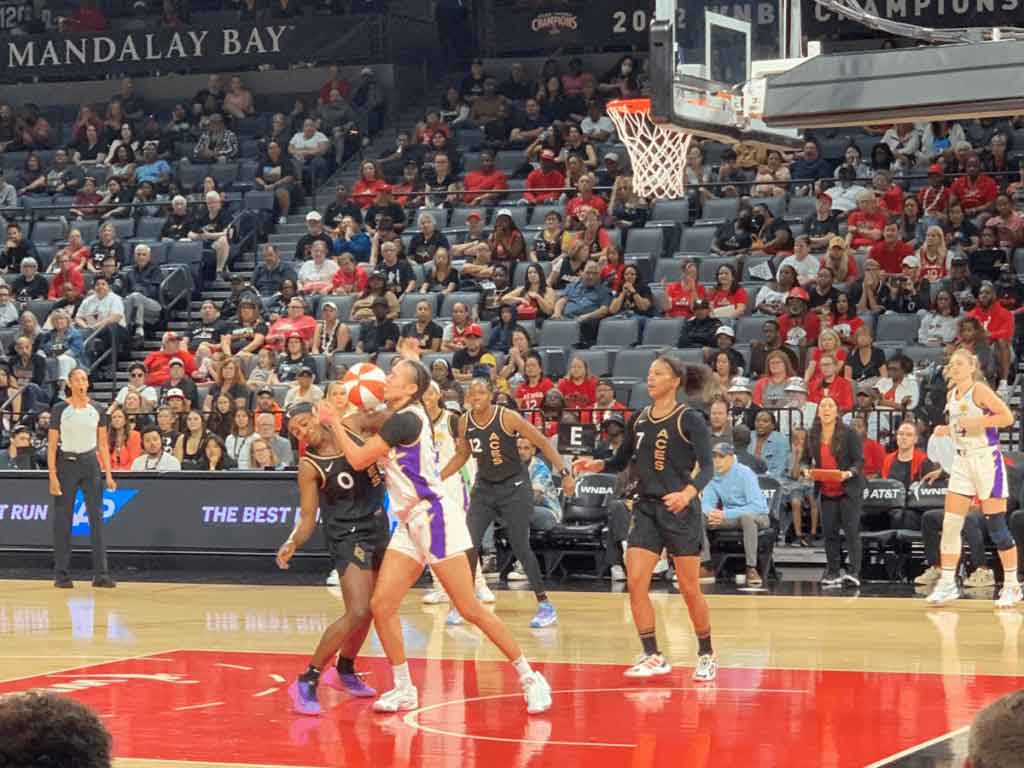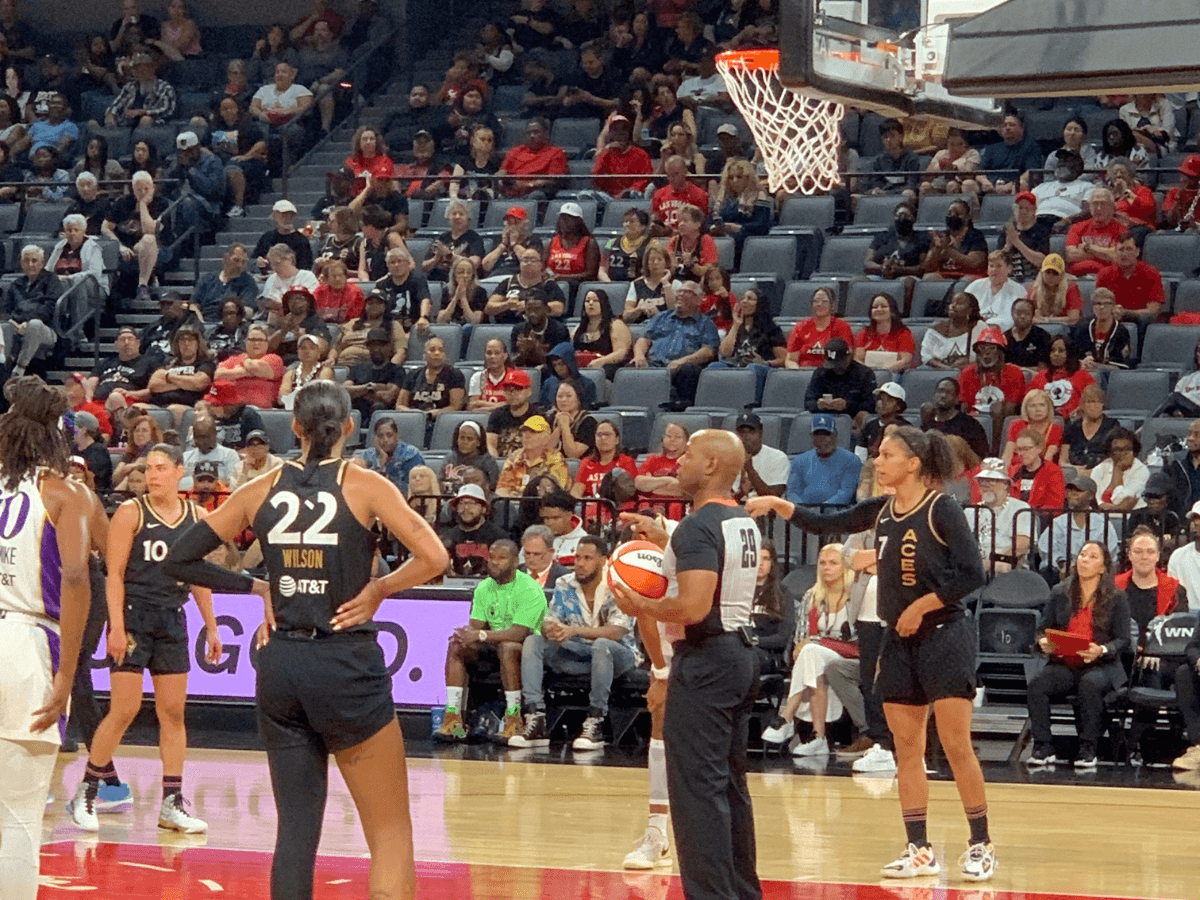Key takeaways:
- WNBA players foul out of a game after committing six personal fouls.
- The WNBA’s six-foul limit is the same as the NBA’s.
- The WNBA’s foul limit is higher than the NCAA’s, where players foul out after committing five fouls.
You’ve likely been worried when one of your favorite WNBA players gets into foul trouble, wondering, “How many fouls does it take to foul out in the WNBA?”
While fouling out is not frequent in the WNBA, it is an aspect that adds another layer of strategy and excitement to the game.
Understanding the foul rules in the WNBA is crucial for both players and fans alike. This comprehensive WNBA guide dives into the specifics of fouling out in the WNBA, the types of fouls, and how they differ from other basketball leagues like the NBA and college basketball.
How Many Fouls to Foul Out in the WNBA
Fouls in basketball are inevitable. Even the best defenders will find themselves out of position after a crafty move by the player they’re guarding. And sometimes, great defenders will get the best of their opponent by establishing a legal guarding position and taking a charge.
So, let’s say you’re noticing the refs blowing their whistle more than usual, and you catch yourself questioning, “How many fouls do WNBA players get?”
In the WNBA, a player fouls out after committing six personal fouls.
According to Section I of RULE NO. 3–PLAYERS, SUBSTITUTES AND COACHES in the latest WNBA Rule Book:
A player is disqualified from the game when she receives her sixth personal foul. No team may be reduced to less than five players.
This rule aligns with the NBA but differs from college basketball, where players foul out after five fouls. The WNBA’s rule is designed to maintain the game’s flow while ensuring fair play.
What Happens When You Foul Out?
Players who foul out in the WNBA are disqualified from the remainder of the game, and a substitute must replace them.
The scorer’ or timer’s table will notify the game officials that the player’s fouled with a buzzer, siren, or a “clearly audible sound.” The team does not incur additional penalties, but losing a key player can be a significant setback.
A player is considered “in foul trouble” when they commit too many personal fouls with respect to the remaining time in the game. For example, a WNBA player who commits two fouls in the first quarter is on track to foul out. In this case, the coach could bench them for some time to limit their risk and ensure they’ll be available down the stretch. Coaches often have to adjust their strategies and rotations when a player is in foul trouble, making every foul crucial.
This is also why attacking an opponent’s best player with isolations can be an offensive strategy. You might drive on the tallest WNBA player dominating the game to see if you can get them to reach or foul by trying to block the shot. Putting them in challenging defensive positions makes them more likely to commit a foul and have to be pulled out of the game.
What Happens if Too Many Foul Out and a Team Runs Out of Players?
The WNBA rulebook states that teams cannot be reduced to less than five players. So what happens if so many players foul out that no substitutes are left?
In this instance, that player who just received their sixth personal foul stays in the game. But at the same time:
- They are hit with both a personal and team foul, and
- A technical foul is assessed against their team.
From there on out, all players who receive six or more personal fouls remain in the game, and the situation is treated the same.

WNBA Rule Changes for 2023
The WNBA has introduced key rule changes for the 2023 season, including a Coach’s Challenge and a heightened penalty for transition take fouls. Even with these changes, the league’s foul-out rules remain the same. Players still foul out after six personal fouls.
With that in mind, here are the changes that the league implemented in 2023:
- Introducing the Coach’s Challenge: The new Coach’s Challenge allows coaches to ask that refs review certain calls, potentially saving players from fouling out. Coaches get one challenge per game but lose a timeout if their challenge is unsuccessful.
- Transition Take Foul gets a heightened penalty: A transition take foul occurs when a defender purposely commits a foul to prevent the offense from having a fast break, without making a legitimate play on the ball. With the new changes, the defender who is called for a take foul is assessed a personal foul (potentially causing them to foul out), plus the offensive team gets a free throw attempt and retains possession of the ball.
- Bench Conduct: Starting in the 2023 season, players on the bench can receive technical fouls or delay of game penalties. Refs can call these if players stand too far away from their team’s bench for too long or if they try to distract the other team using unsportsmanlike behavior.
WNBA vs. NBA: A Comparison
In the WNBA, players can commit up to six fouls before they are disqualified from the game, a rule that aligns with the NBA.
Interestingly, WNBA games are shorter, clocking in at 40 minutes compared to the NBA’s 48-minute games. Despite this time difference, the six-foul limit remains crucial to the game.
Learn more: How long are WNBA games?
Types of Fouls in WNBA Basketball
As we get into the nitty-gritty of WNBA fouls, we must understand the different types of fouls in basketball. There are four primary types: personal, technical, flagrant, and team fouls.
Personal Fouls
These are the most common fouls. They involve illegal physical contact with an opposing player during live play. Some personal fouls you’ve heard of include blocking, hand-checking, reach in fouls, and charging. Personal fouls add to a player’s foul count for fouling out.
Learn more: What is a charge in basketball?
Technical Fouls
These fouls are usually committed for unsportsmanlike conduct. Technicals can be assessed against players, coaches, or even the team for actions like arguing with referees or delaying the game. Technical fouls are not included in a player’s foul count for fouling out.
Flagrant Fouls
These are severe personal fouls that involve excessive or violent contact. Flagrant fouls can result in ejection from the game and may be followed up with additional penalties like fines or suspensions. Flagrant fouls are included in the personal foul count and contribute to a player’s foul count for fouling out.
Team Fouls
Team fouls are the total number of defensive and loose ball fouls (not offensive fouls) committed by a team during a game. Once a team reaches a certain number of team fouls, the opposing team is awarded free throws for each subsequent foul, known as “the bonus.”
WNBA Players with the Most Fouls
With players fouling out after six personal fouls, the dynamics of a game can change dramatically, making every foul count. According to data provided by WNBA.com, here are the top 10 WNBA players with the most fouls committed in the 2023 season.*
| PLAYER | TEAM | TOTAL NUMBER OF PERSONAL FOULS IN 2023 |
| Natasha Howard | Dallas Wings | 140 |
| Satou Sabally | Dallas Wings | 135 |
| Ezi Magbegor | Seattle Storm | 129 |
| Aaliyah Boston | Indiana Fever | 125 |
| Alanna Smith | Chicago Sky | 116 |
| Brittney Sykes | Washington Mystics | 115 |
| Cheyenne Parker | Atlanta Dream | 114 |
| Michaela Onyenwere | Phoenix Mercury | 114 |
| Tiffany Hayes | Connecticut Sun | 114 |
| Jonquel Jones | New York Liberty | 113 |
*Data collected on 9/20/23.
How Often Do WNBA Players Foul Out?
Fouling out in the WNBA is relatively rare, but it does happen. How often players foul out varies and depends on several factors.
Style of Play
The physicality of a team will influence the number of fouls called. More aggressive players often get called for more fouls than finesse players. Also, more skilled defenders generally receive fewer fouls, making it less common for these players to reach the six-foul limit.
Officiating
How a game is officiated will undoubtedly impact how often players foul out. Some refs allow for more physical play and even penalize flopping in basketball. In contrast, others are whistle-happy and stricter about calling fouls for even minor infractions. The officiating style can significantly influence the number of fouls in a game and, consequently, how often players foul out.
Coaching Strategies
Coaches play a crucial role in how often players foul out. When a player accumulates too many fouls early in the game, a coach may bench them to reduce the risk of fouling out. This strategic decision can help keep key players in the game during critical moments, reducing players fouling out.
Statistical Perspective
While exact statistics can vary, generally star players and those who play significant minutes are less likely to foul out. Coaches often manage their rotations and player minutes to minimize the risk of losing a key player to fouls.
Will the WNBA Ever Change the Number of Fouls to Foul Out?
As the WNBA grows and incoming players bring unprecedented skills to the court, the question arises: Is there room for flexibility in the foul rules?
The six-foul limit serves an important purpose. It provides players with some margin for error and enables teams to keep their star players in the game for extended periods. Yes, this leeway can be frustrating to watch at times. But, some argue it’s essential for the league’s evolution, ensuring that fans see the best of what the WNBA has to offer.
By maintaining the six-foul rule, the WNBA aligns itself with the NBA. Hopefully, in doing so, allows for the game’s natural progression and the showcasing of emerging talent.
FAQs
How many fouls are there in the WNBA?
In the WNBA, a player fouls out after 6 personal fouls..
What are the rules for team fouls in the WNBA?
Team fouls can lead to penalty situations but do not contribute to a player’s personal foul count for fouling out.
How many fouls per person in women’s basketball?
In the WNBA, it takes 6 personal fouls for a player to foul out. In NCAA women’s college basketball, players are disqualified after 5 fouls.
What is a foul in the WNBA?
A foul in the WNBA is an illegal action that can be categorized as personal, technical, or flagrant. Technical fouls are not considered personal fouls and do not contribute to a player’s six-foul limit. However, a player gets ejected from a game after two technical fouls.

